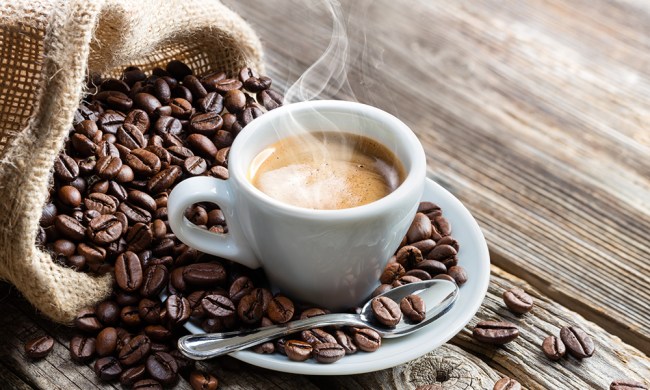Real quick, we want you to think back to a few weeks ago. We’d just entered a new decade. The ball in Times Square has just dropped. Confetti coated every last partygoer around the world and you’ve just kissed the person closest to you (whether it’s the love of your life or a stranger is up to you, but remember that consent is sexy when it comes to that latter option). What happened next? You sang “Auld Lang Syne,” of course. You know the one:
“Should auld acquaintance be forgot / And never brought to mind?”
While you know the words, did you know you have the Scottish poet Robert Burns to thank for what is now the New Year’s Eve celebration song? You didn’t and you want to make up for years of not thanking him? Well, you’re in luck. Every year on January 25, lovers of poetry, Scotland, and all things Robert Burns celebrate Burns Night.
Before we get into how to celebrate Burns Night, let’s learn a little more about the man himself.
Who Is Robert Burns?

Robert Burns was born on January 25, 1759, near Ayr in Alloway, Scotland. Both his parents were tenant farmers and he was the youngest of seven. It wasn’t until the early 1780s that a friend of his, Captain Richard Brown, encouraged him to become a poet. Burns continued to bust his ass at various jobs, had a few children, moved around for work, and eventually ended up in Edinburgh, where he published Poems, Chiefly in the Scottish Dialect in 1787 (book titles were much simpler then, it seems).
Over the next decade, Burns continued to produce poetry, mostly in the Scottish dialect, to great acclaim. Many of-of the poems Burns penned have gone on to popularity, both officially and unofficially, in Scotland over the years. After a hell of a career spanning almost two decades, Burns died in 1797 following a dental extraction. He sired 12 children and had multiple affairs in his lifetime. Because of his work, he became a cultural icon across Scotland. All in all, a productive life, most would say.
What Is Burns Night?

In 1801, five years after his passing, some of Burns’ friends got together to celebrate his life. They ate traditional Scottish food, they drank Scotch whisky, and they recited his poems. This is the tradition that’s been handed down — more or less uninterrupted since its inception — in the form of Burns Night and the Burns Supper, celebrated every January 25 to coincide with Burns’ birthday.
Burns Night is celebrated every year on January 25.
One of the recitations that occurs at every Burns Supper is “Address to a Haggis,” a poem that celebrates one of Scotland’s national dishes (and is also what is supposed to be served on Burns Night, but more on that soon). Here are the first three stanzas of “Address to a Haggis” in the original dialect:
Fair fa’ your honest, sonsie face,
Great chieftain o’ the puddin-race!
Aboon them a’ ye tak your place,
Painch, tripe, or thairm:
Weel are ye wordy o’ a grace
As lang’s my airm.
The groaning trencher there ye fill,
Your hurdies like a distant hill,
Your pin wad help to mend a mill
In time o’ need,
While thro’ your pores the dews distil
Like amber bead.
His knife see rustic Labour dicht,
An’ cut you up wi’ ready slicht,
Trenching your gushing entrails bricht,
Like ony ditch;
And then, O what a glorious sicht,
Warm-reekin, rich!
Have no clue what that means? Here is a translation, courtesy of the Alexandria Burns Club:
Good luck to you and your honest, plump face,
Great chieftain of the sausage race!
Above them all you take your place,
Stomach, tripe, or intestines:
Well are you worthy of a grace
As long as my arm.
The groaning trencher there you fill,
Your buttocks like a distant hill,
Your pin would help to mend a mill
In time of need,
While through your pores the dews distill
Like amber bead.
His knife see rustic Labour wipe,
And cut you up with ready slight,
Trenching your gushing entrails bright,
Like any ditch;
And then, O what a glorious sight,
Warm steaming, rich!
Of course, any Burns Supper needs some actual victuals. Traditionally, as we mentioned, haggis is the centerpiece of the meal. Haggis, for those that don’t know, is a pudding made of sheep’s heart, liver, and lungs mixed with vegetables and spices, then served in the animal’s stomach. It doesn’t sound delicious, but it is.
How to Celebrate Burns Night
You can buy haggis online, but once you’ve bought the good stuff, how do you prepare it? Check out the recipe below for haggis with neeps and tatties (turnips and potatoes), which was developed by Jeff Bland for Scotland.
A meal wouldn’t be complete without something to drink, and with this being a Scottish meal, whisky is the way to go. A dram of your favorite whisky is perfect, but you could also mix up a few Scotch cocktails while you’re at it.
Traditional Haggis with Neeps (Turnips) and Tatties (Potatoes)

Ingredients:
- 400 g of haggis (purchased from a good quality butcher)
- 8 shallots
- 4 baking potatoes
- 3 cloves of garlic
- 1 turnip
- 1 sprig of thyme
- 50 g butter
- 50 g creamtu
- 50 g of sugar
- 500 ml of brown chicken stock
- 200 ml of red wine
- 200 ml of cream
- 80 ml of port
- 10 ml of whisky
- Salt
Method:
- Scrub the potatoes and bake them whole in the skins in the oven at 180 degrees Fahrenheit until cooked. Remove from the oven and scoop out the flesh of the potatoes and pass through a fine sieve or potato ricer. Add in the cream and butter, and mix.
- At the same time, peel and dice the turnip, then cook in salted water. Pass through a fine sieve or potato ricer.
- Follow the butcher’s instructions for the haggis based on size.
- Use a round metal ring and layer with one third of haggis layer followed by a third of mashed turnip before adding the mashed potatoes to fill the ring.
- To heat, put in a medium oven until warm.
- Make a stock from the port, red wine, sugar, garlic, thyme and salt. Simmer in a pan together with the shallots until tender. Remove the tough outside layer of the shallots when cooked.
- Make a whisky sauce with the brown chicken stock and cream before adding the whisky at the end to taste.
- Serve the timbale of haggis with shallots and the whisky sauce.



